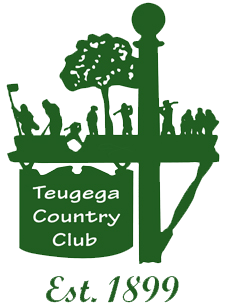History
Franklin Ethridge was searching for a little outdoor exercise. The rigors of running Rome's leading wholesale house at James and Front streets had become so wearying that his doctor suggested he seek healthful recreation.
About this same time, Ackley Tuller, now retired from his successful grocery store, was beginning to play golf in a pasture he owned along Turin Street. The 43-year old Ethridge, once a varsity baseball player at Yale, and some others began to join Tuller in this peculiar new pastime. The grass was often too high and the bulls not always friendly but the game, as it was wont to do, steadily worked its way into the blood. It was decided that a golf course should be formed in the city of Rome.
The meeting that would result in Teugega Country Club convened on a Friday evening in February 1899 at the Arlington Hotel. Ethridge invited 125 Romans, including many of Rome's most prominent citizens. There was William R. Huntington, president of the First National Bank, Theodore J. Mowry, founder and publisher of The Harness Gazette, Edward Comstock, son of Rome's first mayor and a Division Commander under General Tecumseh S. Sherman in the Civil War. Also president was Rome Electric Company founder Herbert T. Dyett, whose great-grandfather, Judge Joshua Hathaway, had turned the first shovelful of dirt for the Erie Canal alongside Governor DeWitt Clinton on July 4, 1817. Perhaps most distinguished of all was 75-year old Dr. Willey L. Kingsley, then in his second term as Rome's mayor. Dr. Kingsley was one of New York's most respected men, a physician in Rome for over 50 years and a pioneer in the treatment of malignant growths.
It was the first time golf had been dreamed of in Rome; two years earlier an effort to organize a club was unsuccessful. Ethridge was able to pull it together and he became known as "the father of golf in Rome.
At a second meeting the organizing and management skills of these men quickly became apparent. Officers were elected, with Ethridge, the driving force behind the club, named President. Development committees were formed on Organization, Constitution and By-Laws, Grounds and Membership. Each of the 19 founders in attendance left the Arlington Hotel with a specific job to do. The Constitution and By-Laws were adopted at a meeting November 1899 and a site selected for the course.

Attorney Eugene Rowland, A Phi Beta Kappa and Salutatorian at Madison College (later Colgate University), nominated the name "Te-uge-ga", referenced in the 1851 Annals of Oneida County as the local Indian's designation for the Mohawk River. The name would standup through several challenges over the years but even survived the uprooting to Lake Delta where it would remain safely ensconced.
In 1900, land along the Mohawk River, today known as Mohawk Acres, was officially leased and on Decoration Day 1900 Teugega Country Club opened for play on their new 9-hole course.
By 1912 there were indications that the original member-designed nine holes were no longer challenging enough for the players. The Greens Committee was instructed to develop additional hazards to make the course sportier and for the first time money was set aside in the budget for sand disbursement: $2.00. By 1916 Teugegans were clearly serious about golf and the Club joined the United State Golf Association.
The course was laid out on some of the worst golfing ground imaginable. Any amount of rain left the low-lying terrain unplayable and the spring thaw typically resulted in a quagmire that kept golfers away until late May. If membership was to increase and Teugega was to grow, a new course would have to be built elsewhere.
The Board of Directors was not going to leave such an important move to chance. Barton Hasleton, Chairman of Rome Brass and Copper Co. had befriended Donald Ross while traveling in North Carolina and invited the famous golf course architect to evaluate his home course in Rome. When Ross came to inspect the Teugega links, he confirmed what many had ruefully come to believe. "Outside of one other course that was built out of a swamp, this is the second worst course in the country," Ross said. His services were soon retained to design a new 18-hole course six miles to the north of Rome at Lake Delta.
Ross worked from topographic maps, drawing up blueprints for his course routings, famous for requiring little walking from one green to the next tee. Although much of the work at Teugega was directed by Cassius Halstead, Teugega charter member and Chairman of the Delta Golf Construction Committee, and Ross' associate Walter Hatch, Ross himself visited Rome on several occasions.
Ross was 47 years old when he came to Rome. The son of a stonemason and nurse in the north Scottish coastal town of Dornoch, he apprenticed under legendary "Old" Tom Morris, creator of many of the storied British seaside links. Ross came to America in 1899 to be the professional of the Oakley Country Club in Watertown, MA. The following year he received a commission to create the courses at the new Pinehurst resort in the North Carolina sandhills. Here he would reside for the better part of fifty years, creating course designs from a cottage nestled behind the third green.
In 1921 a letter was sent notifying members to vacate all lockers prior to June 25. A week later, a formal opening took place over a three-day Independence Day celebration to mark the occasion of the opening of the new Donald Ross 18-hole Teugega course.
Ross was widowed in 1922 by the death of his first wife, Janet Conchie. While a visitor in Rome, Ross stayed at the home of his friend Haselton. Through this association, Ross became acquainted with and began to court Hasleton's secretary, Miss Susan Aldridge. A golfer herself, Miss Aldridge was the first ever women's champion at Teugega in 1921. An engagement was announced but the romance ended tragically when Miss Aldridge was stricken by cancer and died. Ross would later play a round at Teugega and reportedly scored his first ever hole-in-one at the 140-yard 7th hole, one of his favorite short holes.
The finished course reflects many of the hallmarks of a Ross-designed course. The basic routing of the holes unfolds in a fan-shape, with the clubhouse at the handle. The 1st tee, 9th green, 10th tee and 18th green all lie within easy pitching distance from the clubhouse. The holes themselves zigzag across the terrain without consecutive fairways racing down the same direction.
Teugega endures today as one of the best remaining legacies to the work of Donald Ross.
